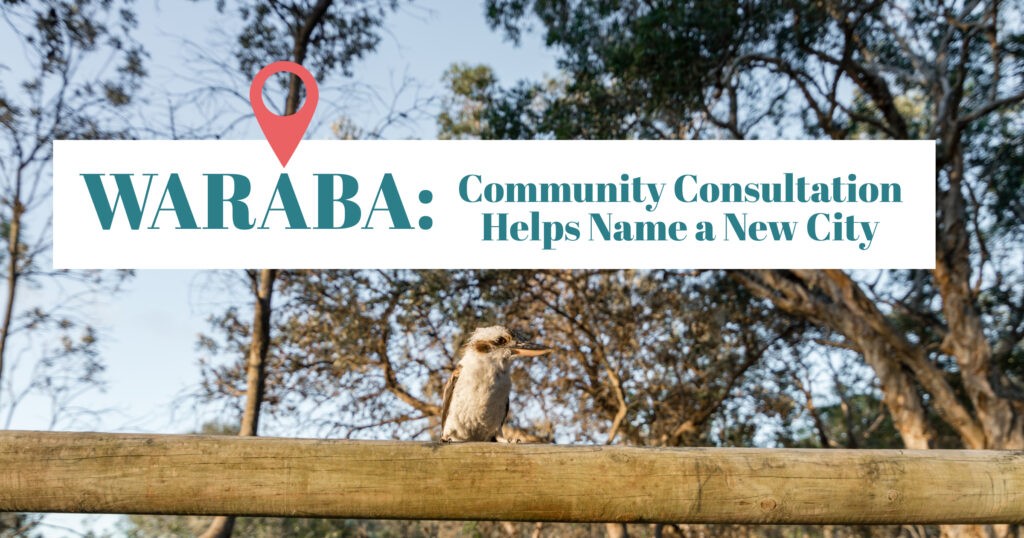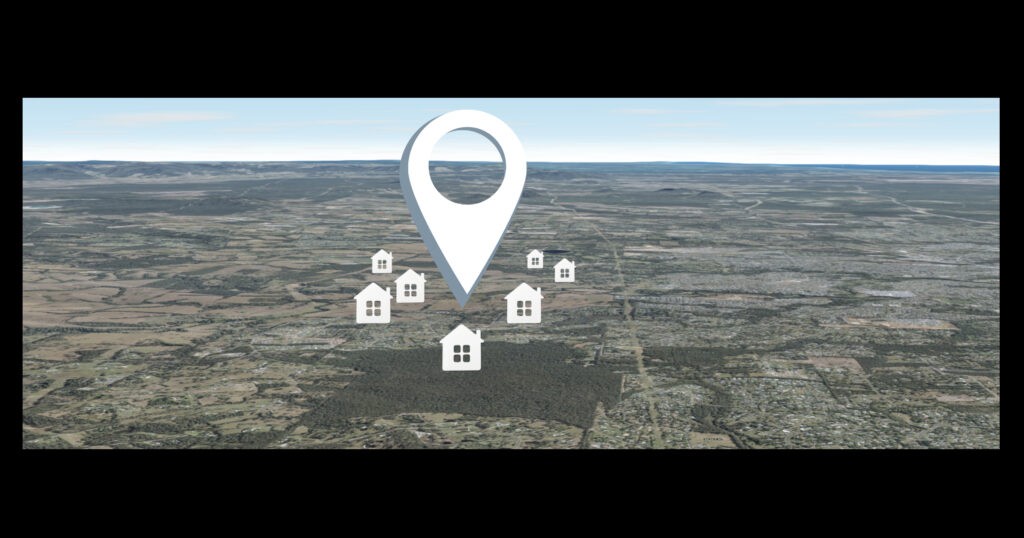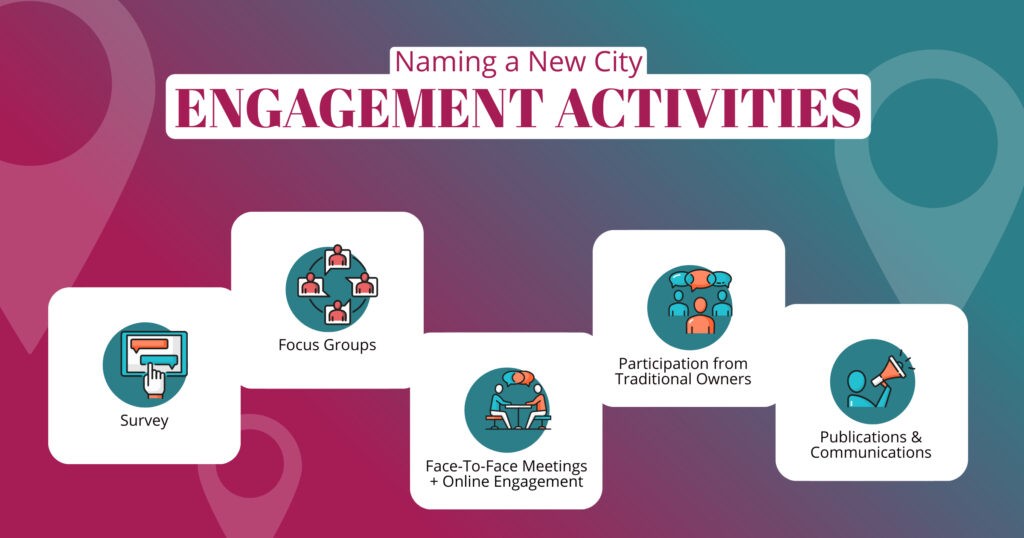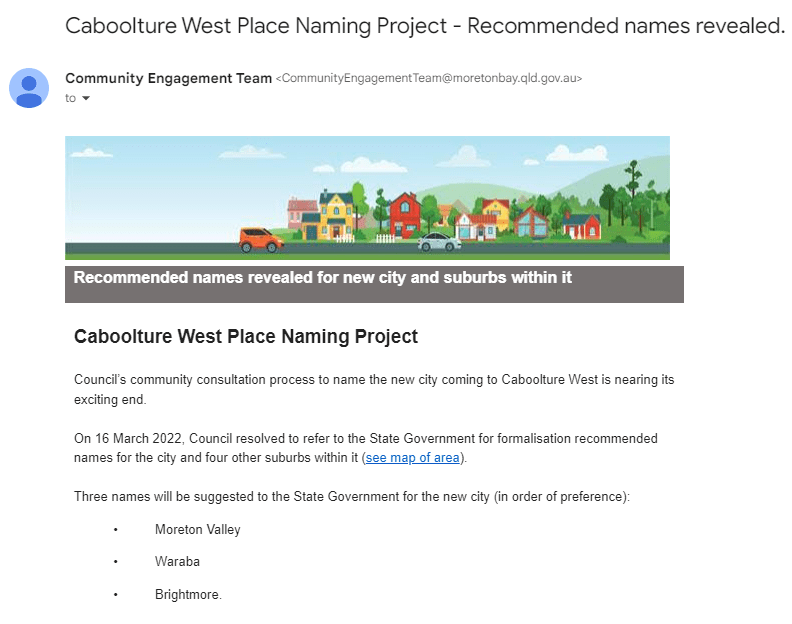Introducing Waraba: Community Consultation Helps Name a New City

We recently came across an interesting example of community consultation that we wanted to shine the light on.
Waraba is a new city/suburb in South-East Queensland, Australia — or at least, it’s about to become one. This new city was named through a rigorous process of community consultation that earned a Highly Commended placing for the Planning category at the 2023 IAP2 Australasia Core Values Awards.
So, let’s take a look at the community consultation processes put in place by the Moreton Bay Regional Council, and what we can learn from them and apply to other projects.
Background on Waraba

With significant population growth forecast in Australia’s South East Queensland and the Moreton Bay Region, the local council set aside an area known as ‘Caboolture West’ for a future development that would eventually house 70,000 residents. At the time of planning, this region bordered several existing suburbs, but mainly consisted of semi-rural farmland.
As part of the planning process, the Moreton Bay Regional Council needed to come up with a name for the new city, as well as several suburbs within the region. It was important to determine names early on to help residents build a connection with the place, to build identities for the area, to identify suburb boundaries, to make it easier for postal and emergency services to find locations, and to protect any borderline communities from identity confusion.
After a series of announcements and planning updates between 2012 and 2021, the council started the Caboolture West Place Naming Project, kicking off community consultation in April 2021.
Objectives for Suburb Naming Consultation
We’ve often spoken about the importance of starting your consultation with clear goals and objectives — and this consultation was no exception, beginning with some strong goals. The two main stated objectives were:
- To gain community input into the naming processes, ensuring that the name would be influenced by community values and suggestions, and increase community support for the new names and boundaries
- To protect the identity of existing communities by understanding impacts on existing residents, understanding existing suburb identities, and determining new boundaries for nearby suburbs
Relevant Legislation
The act of naming a place is (in many jurisdictions) covered under specific legislation. In Queensland, this legislation is the Place Names Act 1994.
It’s worth mentioning that some degree of consultation is legally required under this act. For instance:
- Although the Minister may give a name to a place (7), this is subject to conditions
- There must be consideration of place naming issues (6), including community views, cultural and historical significance, and Aboriginal tradition and Island custom
- Generally, the Minister must publish a notice of a place naming proposal that is published in the gazette and at least one other place (e.g. a relevant website, electronic newspaper, regional newspaper, or another way that’s considered appropriate)
- The notice must invite written submissions about the proposal from interested people, groups, and bodies
- They must also similarly publish their decision about the proposal
6-Step Process
The council reported a six-step naming process:
- Agreeing on the methodology
- Defining suburb boundaries
- Gathering ideas for names
- Selecting names
- Formalising names with the state
- Name approval and adoption
Throughout each step in the process, the council employed various stakeholder engagement and community consultation approaches, in line with their official principles, process, and approach.
Community Consultation Activities

Some of the activities and tools used to engage with the community for naming Waraba included:
A Survey
The local community were invited to share their perspectives across several surveys, including an initial survey to understand their aspiration for the new city and naming ideas. Developers were also encouraged to complete this survey, which was promoted via email, media releases, social media, advertising, displays, and more. Independent consultants were engaged to manage the Name Your Place community survey and collect responses.
Suburb Boundary Focus Groups
Community members were invited to nominate for focus groups. These groups (together with the Department of Resources present) were used to discuss and document key issues, such as community values, boundary alignments, and the definition of specific communities.
Face-To-Face Meetings
With the project launch coinciding with COVID-19 lockdowns and school closures, the council had to adapt their plans by offering online engagement options, teleconferencing, modifying focus groups, and adjusting timeframes. However, some face-to-face meetings were held — in particular with key stakeholders, such as Traditional Owners and both local and state government representatives.
You can learn more about alternative engagement methods in our blog on remote stakeholder engagement.
Engaging With Traditional Owners
It was important for the council to engage with the local Kabi Kabi people, who are the First Nation Traditional Owners within the region. Their input was critical to ensure that any new place names would:
- Be culturally and historically appropriate
- Accurately reflect the local indigenous language
- Have the support of Traditional Custodians
Council specifically sought out Kabi Kabi language experts, consulting them throughout the project and ensuring their participation in the Place Naming Committee.
Publications & Communications

Throughout the community consultation process, a number of communications were sent out to stakeholders, along with supporting publications and resources to encourage participation and keep stakeholders informed.
Relevant publications and resources included:
Key Results
Most importantly, as a result of community engagement, names were successfully chosen, approved, and announced for the Caboolture West Area. On April 14 2023, the following city and suburb names were formalised by the Department of Resources Minister:
- Waraba
- Lilywood
- Wagtail Grove
- Greenstone
- Corymbia
In addition to this, the council achieved their objectives, getting significant input from local stakeholders (410+ participants) to understand local suburb identities and boundaries, while gathering ideas. They also achieved participation and endorsement from local Kabi Kabi representatives. In fact, the new city name, Waraba, comes from the Kabi Kabi indigenous language and means ‘burn’, and references traditional land management practices, new life, and a healthy land and people.
Of course, another outcome was that the council had an opportunity to start conversations with stakeholders and strengthen those relationships — which will likely flow into other engagement opportunities in the future via their ongoing Your Say Moreton Bay platform.
Learnings
The engagement is considered Queensland’s largest local government-initiated collaborative place-naming process — and there’s much to learn from their process, which incorporated legislative requirements, community involvement, and stakeholder engagement.
Perhaps one of the most interesting takeaways for engagement professionals is the importance of enabling meaningful participation from Traditional Custodians. There are many other projects that could benefit from a similar approach. In fact, following this place naming project, the Queensland Department of Resources has since updated their guidance materials to consider the use of traditional materials in place naming criteria.
Another takeaway is that you don’t need a big budget or team to see results or have a significant impact. With the right community consultation processes and tools in place (a community engagement tool like Simply Stakeholders certainly helps!) you can stretch your resources to get input and insights from the stakeholders that matter most.
Finally, change can elicit strong responses from the local community (just look at some of the council’s early Facebook posts announcing the project!) but given the opportunity to participate in something they can influence, community members can feel like they’re part of the change.
Discover More
We’ve got plenty of other articles that cover topics like this one. Check out:






























